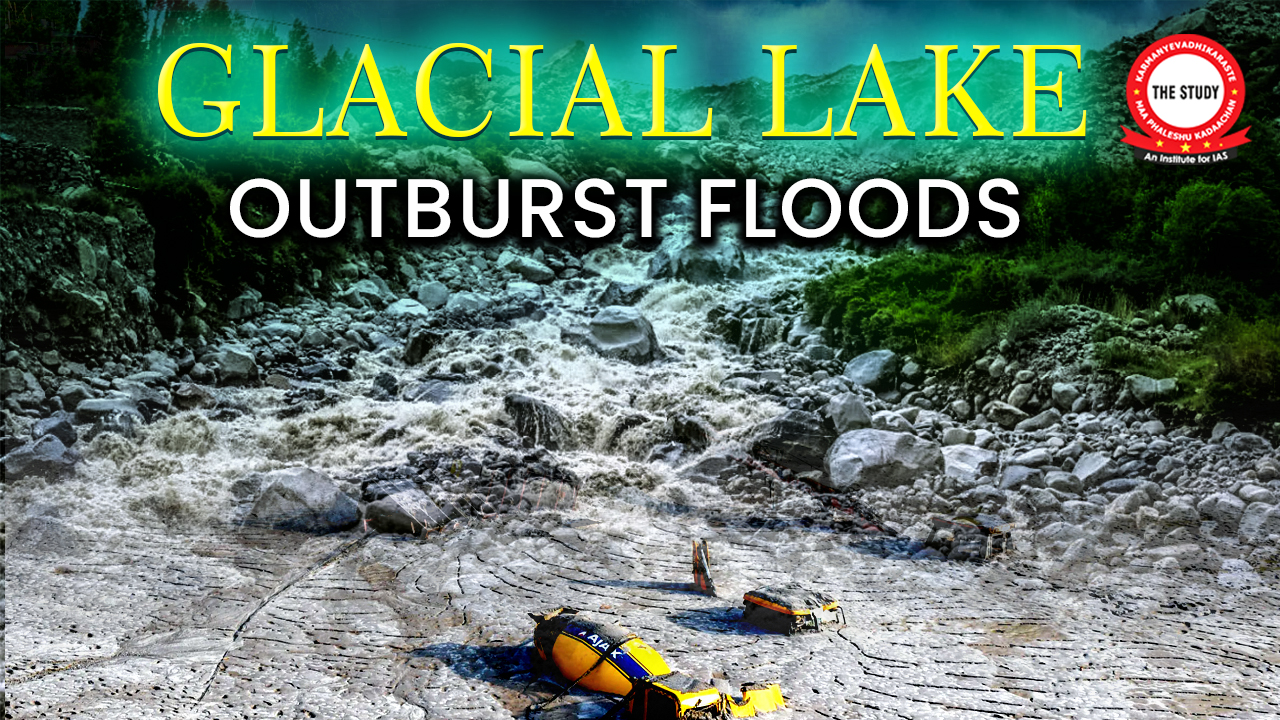Font size:
Print
Glacial Lake Outburst Floods (GLOFs)
Context:
Ahead of the monsoon season, Uttarakhand’s State Disaster Management Department (USDMA) plans to conduct a vulnerability study on 13 glacial lakes, five of which are in high-risk zones, to prevent potential calamities like lake outbursts.
More on News:
- Lakes in Darma, Lasaryanghati, and Kutiyangti valleys of Pithoragarh district, and Vasudhara Tal in Chamoli district, among the 13 studied, are categorised as high-risk due to their locations at elevations exceeding 4,000 metres above sea level.
- These lakes, ranging from 0.02 to 0.50 square kilometres in size, are under scrutiny by Uttarakhand’s State Disaster Management Department (USDMA) to assess vulnerability and mitigate potential risks during the upcoming monsoon season.

What is a GLOF?
- A Glacial Lake Outburst Flood (GLOF) is a sudden release of water from a glacial lake due to the breach of a natural dam formed by ice or sediment.
- This can lead to catastrophic flooding downstream, causing extensive damage to infrastructure, property, and loss of life.
Causes of GLOFs:
- Climate Change and Glacier Melting: The warming of the troposphere accelerates glacier melting, forming unstable glacial lakes.
- Glacier Retreat and Surging: Melting glaciers leave depressions that fill with water, increasing the risk of GLOFs.
- Avalanches and Earthquakes: Avalanches, landslides, or seismic activity can disrupt natural dams, triggering floods.
- Extreme Weather: Heavy rainfall and sudden temperature changes can destabilise glacial lakes.
- Human Activities: Construction, mining, and deforestation near glacial lakes can increase the risk of GLOFs.
Examples of GLOFs:
- Bhutan (1994): Lugge Tsho’s outburst highlighted the region’s vulnerability to glacial melting.
- Nepal (1985): Dig Tsho’s floodwaters caused significant downstream damage.
- India (2013): The Kedarnath flash flood in Uttarakhand caused by Chorabari Tal’s outburst killed over 5,000 people.
Impacts of GLOFs:
- Loss of Life and Property: Sudden floods can kill people and destroy infrastructure, including houses, roads, and power plants.
- Disruption of Livelihoods: GLOFs can reduce access to resources and markets, affecting local communities’ income and tourism.
- Environmental Damage: Floods alter landscapes, erode soil, and impact water quality.
- Transboundary Impact: GLOFs can affect areas far from their origin, crossing national boundaries.
India’s Vulnerability to GLOFs:
- ISRO’s Glacial Lake Atlas: Identified over 28,000 glacial lakes in the Himalayan region, with many classified as high-risk.
- State Assessments: Sikkim, Uttarakhand, and Jammu & Kashmir have numerous vulnerable lakes.
- Geological Instability: The Himalayan region is geologically active, making it prone to earthquakes and landslides, increasing GLOF risks.
Mitigation Measures:
- Identification of Dangerous Lakes: Use field observations and historical data to identify high-risk lakes.
- Use of Technology: Employ Synthetic-Aperture Radar imagery and drones for monitoring lake conditions.
- Structural Management: Techniques like controlled breaching, pumping, or tunnelling to lower water volume.
- Early Warning Systems: Enhance sensor-based systems for timely alerts to at-risk communities.
- Construction Codes: Develop uniform construction standards for infrastructure in vulnerable zones.
- Training Local Manpower: Train local communities for rapid disaster response and search-and-rescue operations.
Way Forward:
- Monitoring and Data Collection: Continuous monitoring of glacial lakes and downstream water levels.
- Enhanced Safety Standards: Revise safety standards for infrastructure projects in mountainous areas.
- Scientific Research: Scale up studies on glaciers to understand their response to climate change.
- Balancing Development: Ensure hydropower and other projects include robust safety mechanisms to mitigate GLOF risks.
Implementing these measures can help mitigate the impacts of GLOFs, protecting lives, property, and the environment in vulnerable regions.





